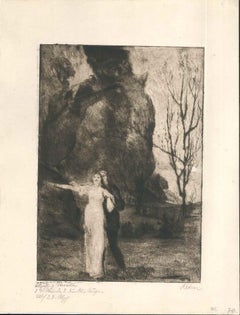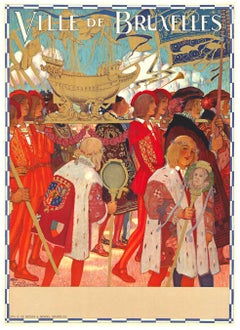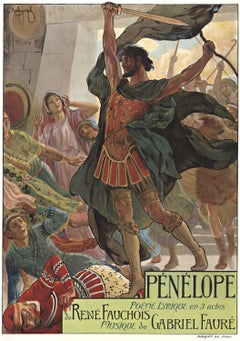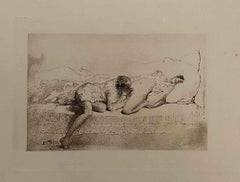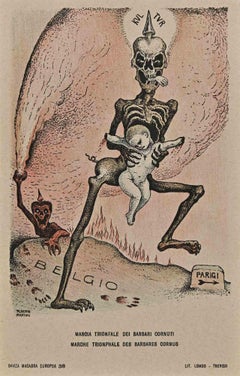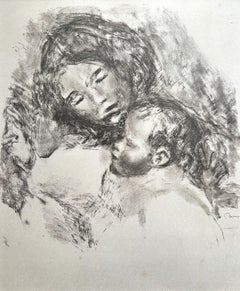1910s Figurative Prints
to
64
390
65
82
13
18
Overall Width
to
Overall Height
to
191
63
24
12
7
1
1
1
1
101
34
22
18
17
3,533
7,600
25,053
6,445
295
599
1,410
1,230
1,260
2,238
3,198
5,156
2,817
1,291
3,031
371
194
2
521
258
239
205
162
123
120
66
64
62
46
42
37
26
22
21
18
17
14
14
198
177
129
114
74
39
192
259
240
Period: 1910s
Mein Weg mit dem Weib #14 - Original Etching by W.R. Rehn
Located in Roma, IT
Drypoint and aquatint (brown ink) on cream paper.
Signed "Rehn" in pencil on the lower right margin. Titled and numbered in pencil on the lower left margin. Edition of 25 prints. Fr...
Category
Symbolist 1910s Figurative Prints
Materials
Drypoint, Aquatint
Orignal Ville de Bruxelles City of Brussels vintage poster 1914
Located in Spokane, WA
Original Ville de Bruxelles (City of Brussels, Belgium) vintage art nouveau poster. This beautiful lithograph is in excellent condition, ...
Category
Art Nouveau 1910s Figurative Prints
Materials
Lithograph
$2,360 Sale Price
20% Off
Original 'Penelope" vintage 1913 opera poster
Located in Spokane, WA
Original linen-backed stone lithograph opera poster for Penelope. Done in 1913 by the great lithographer Georges Rochengrosse who created several opera ...
Category
Art Nouveau 1910s Figurative Prints
Materials
Lithograph
$599 Sale Price
20% Off
Erotic Scene - Héliogravure by Micheal Von Zichy - 1911
Located in Roma, IT
Erotic scene is an original Héliogravure artwork on ivory-colored paper, realized by Micheal Von Zichy in 1911. Printed in only 300 copies, Leipzig; Privatdruck, from the Catalogue ...
Category
Modern 1910s Figurative Prints
Materials
Paper, Engraving
The European Macabre Dance N.38 - Lithograph by A. Martini - 1915
Located in Roma, IT
The European Macabre Dance N.38 is a hand-colored lithograph, from the Series "La Danza Macabra Europea" illustrated by Alberto Martini (Oderzo, 1876 – Milan, 1954) in 1915.
Signed ...
Category
Symbolist 1910s Figurative Prints
Materials
Lithograph
Maternity : Mom & His Child - Original Lithograph Signed Plate - Delteil 50
Located in Paris, IDF
Pierre Auguste Renoir (1841-1919)
Maternity, 1910
Original lithograph
Signed in the plate
Edition of 100 copies
On China paper size c. 60 x 49 cm (c. 23.6 x 19.3 in)
In a beautiful ...
Category
Impressionist 1910s Figurative Prints
Materials
Lithograph
La Croix-Soleil original vintage French lithograph
Located in Spokane, WA
Original La Croix-Soleil, artist Leonetto Cappiello (1875 - 1942) lithograph vintage poster. This La Croix-Soleil lithograph is an original, archival linen backed and ready to fra...
Category
Art Deco 1910s Figurative Prints
Materials
Lithograph
Baigneuse debout à mi-jambes
Located in Santa Monica, CA
PIERRE-AUGUSTE RENOIR (French, 1841 - 1919)
BAIGNEUSE DEBOUT A MI JAMBES (D., S. 23)
Etching, 1910, a later impression on laid paper, the only state. Full margins with deckle edge...
Category
Impressionist 1910s Figurative Prints
Materials
Etching
$760 Sale Price
20% Off
Nijinsky in Cleopatre.
Located in London, GB
BARBIER, George.
Nijinsky in Cleopatre.
London, C. W. Beaumont, 1913.
‘The designs, although somewhat fantastic in treatment, do convey the impression produced by Nijinsky in hi...
Category
Art Nouveau 1910s Figurative Prints
Materials
Lithograph
Original Buy War Savings Stamps WW1 lithograph vintage poster
Located in Spokane, WA
Original WW1 vintage poster: HELP HIM WIN BY SAVING AND SERVING, W.S.S., BUY WAR SAVINGS STAMPS. Original World War 1 vintage stone lithograph. Museum archival linen backed and...
Category
American Realist 1910s Figurative Prints
Materials
Lithograph
$600 Sale Price
20% Off
Mein Weg mit dem Weib, plate 10
Located in Roma, IT
Drypoint and aquatint (brown ink) on cream paper.
Signed "Rehn" in pencil on the lower right margin. Titled and numbered in pencil on the lower left margin. Edition of 25 prints. Fro...
Category
Modern 1910s Figurative Prints
Materials
Drypoint, Etching, Aquatint
Picasso, Composition (Hodorisch B2), Le manuscrit trouvé dans un chapeau (after)
Located in Southampton, NY
Lithograph on vélin des papeteries Lafúma paper. Unsigned and unnumbered, as issued. Good condition. Notes: From the album, Le manuscrit trouvé dans un chapeau, orné de dessins a la ...
Category
Modern 1910s Figurative Prints
Materials
Lithograph
$716 Sale Price
20% Off
Picasso, Composition (Hodorisch B2), Le manuscrit trouvé dans un chapeau (after)
Located in Southampton, NY
Lithograph on vélin des papeteries Lafúma paper. Unsigned and unnumbered, as issued. Good condition. Notes: From the album, Le manuscrit trouvé dans un chapeau, orné de dessins a la ...
Category
Modern 1910s Figurative Prints
Materials
Lithograph
$716 Sale Price
20% Off
The European Macabre Dance n.25 - Lithograph by A. Martini - 1915
Located in Roma, IT
The European Macabre Dance n.25 is a hand-colored lithograph, from the Series "La Danza Macabra Europea" illustrated by Alberto Martini (Oderzo, 1876 – Milan, 1954) in 1915.
Origina...
Category
Symbolist 1910s Figurative Prints
Materials
Lithograph
France at her Furnaces
By James McBey
Located in Storrs, CT
1917. Etching. Hardie 175. 8 x 15 (sheet 10 1/8 x 16 15/16). Edition 76. Slight mat line; otherwise excellent condition. A rich impression printed on antique laid paper with full m...
Category
Modern 1910s Figurative Prints
Materials
Drypoint, Etching
L'Amour La Danse, Impressionist Woodcut by Raoul Dufy
By Raoul Dufy
Located in Long Island City, NY
Raoul Dufy, French (1877 - 1953) - L'Amour La Danse, Year: 1915, Medium: Woodcut on laid paper, signed in pencil, Image Size: 10 x 8 inches, Size: 14.25 x 13.5 in. (36.2 x 34.29 cm...
Category
Impressionist 1910s Figurative Prints
Materials
Woodcut
Saltimbanques : Head of a Woman - Original etching (Bloch #6 / Baer #7c)
Located in Paris, IDF
Pablo PICASSO (1881-1973)
Acrobats: Head of a Woman, 1913
Original etching (Paul Fort Workshop)
Unsigned
On Arches vellum, 48 x 38 cm (c. 19 x 15 in)
REFERENCE:
- Bloch Catalogue R...
Category
Modern 1910s Figurative Prints
Materials
Etching
Bayros-Mappe III - Héliogravure by Fraz von Bayros - 1913
Located in Roma, IT
Héliogravure on japanese paper realized by Fraz von Bayros in 1913 for Ex Libris Verlag K. Th. Senger, Munich.
Mounted on passepartout. Edition of 260, hand signed in pencil by the ...
Category
Symbolist 1910s Figurative Prints
Materials
Photogravure
Nijinsky as 'the poet' in Les Sylphides.
Located in London, GB
BARBIER, George.
Nijinsky as 'the poet' in Les Sylphides.
London, C. W. Beaumont, 1913.
‘The designs, although somewhat fantastic in treatment, do convey the impression produced b...
Category
Art Nouveau 1910s Figurative Prints
Materials
Lithograph
"Peter Pathe Marie Hagan" Original Lithograph Poster by Walter Schnackenberg
Located in Chicago, IL
Original vintage lithograph poster with depiction of Munich-based balletic duo Peter Pathe and Maria Hagen. Design by Walter Schnackenberg (German, 1880-1961). A very scarce example....
Category
Art Nouveau 1910s Figurative Prints
Materials
Lithograph
Traum - Etching by Fritz Schwimbeck - 1918
Located in Roma, IT
Etching realized by Fritz Schwimbeck in 1918.
Edition of 125 realized in Munich on mulberry paper.
Hand signed in pencil.
Category
Symbolist 1910s Figurative Prints
Materials
Etching
The Picador Incites the Bull.
By James McBey
Located in Storrs, CT
The Picador Incites the Bull. 1911. Drypoint. Hardie 104. 6 1/4 x 9 7/8 (sheet 8 1/4 x 11 7/8). Edition 30, #5. Slight mat line, 1 hinge stain in the lower margin, well outside the i...
Category
Modern 1910s Figurative Prints
Materials
Drypoint
$1,200 Sale Price
27% Off
The European Macabre Dance N.28 - Lithograph by A. Martini - 1915
Located in Roma, IT
The European Macabre Dance N.28 is a hand-colored lithograph, from the Series "La Danza Macabra Europea" illustrated by Alberto Martini (Oderzo, 1876 – Milan, 1954) in 1915.
Signed...
Category
Symbolist 1910s Figurative Prints
Materials
Lithograph
The Matador.
By James McBey
Located in Storrs, CT
The Matador. 1911. Drypoint. Hardie 109. 6 7/8 x 10 7/8 (sheet 7 7/8 x 12). Edition 15. A few scattered foxing marks and slight mat line; otherwise fine o...
Category
Modern 1910s Figurative Prints
Materials
Drypoint, Etching
$1,200 Sale Price
27% Off
The Pool of London.
Located in Storrs, CT
The Pool of London. c. 1915. Etching and drypoint. 7 7/8 x 15 7/8 (sheet 11 x 14 7/8 x 21 1/4). A rich impression with drypoint burr printed on the full sheet of simili-Japan paper. ...
Category
Modern 1910s Figurative Prints
Materials
Drypoint, Etching
$1,500 Sale Price
23% Off
Original Uncle Sam Needs that Extra Shovelful (of Coal) vintage poster
Located in Spokane, WA
Original World War 1 poster: Uncle Sam Needs That Extra Shovelful (of Coal.) If you like the Uncle Sam image, this is a good one to have. Help Unc...
Category
American Realist 1910s Figurative Prints
Materials
Lithograph
Nijinsky in Petrouchka.
Located in London, GB
BARBIER, George.
Nijinsky in Petrouchka.
London, C. W. Beaumont, 1913.
‘The designs, although somewhat fantastic in treatment, do convey the impression produced by Nijinsky in h...
Category
Art Nouveau 1910s Figurative Prints
Materials
Lithograph
NIGHT WINDOWS
By John Sloan
Located in Portland, ME
Sloan, John (American, 1871-1951). NIGHT WINDOWS. Morse 152. Etching and drypoint, 1910. The 5th state of 5. Edition of 100. Titled, signed, and inscribed...
Category
1910s Figurative Prints
Materials
Drypoint, Etching
Mein Weg mit dem Weib #18 - Original Etching by W.R. Rehn
Located in Roma, IT
Drypoint and aquatint (brown ink) on cream paper.
Signed "Rehn" in pencil on the lower right margin. Titled and numbered in pencil on the lower left margin. Edition of 25 prints. Fr...
Category
Symbolist 1910s Figurative Prints
Materials
Drypoint, Aquatint
Mort de l'Amour, Series of 8 Erotic Limited-Edition Wood Engravings.
Located in Cotignac, FR
A set of 8 erotic early 20th Century wood engravings on arches paper, a limited edition, number 241 of 1000, by Andre Rouveyre. Produced by Kauffmann on...
Category
Art Nouveau 1910s Figurative Prints
Materials
Paper, Ink
Ottokar Mascha Folio, plate 8: "Poster for the 1st Vienna Secession Exhibition"
By Gustav Klimt
Located in Chicago, IL
After GUSTAV KLIMT (1862-1918) THESEUS UND MINOTAURUS, 1898, final design submission for poster advertising the first exhibition of the Vienna Secession, (In Mascha, no. 8) As a cele...
Category
Vienna Secession 1910s Figurative Prints
Materials
Lithograph
Alphonse Mucha Zdenka Cerny 1913 Lithograph (Rare and Large)
Located in Dallas, TX
Alphonse Mucha (Czech, 1860-1939) Original Lithograph 1913 - Very Large -
"Zdenka Cerny" The Greatest Bohemian Violincellist
Prague, Czechoslovak
Color lithograph
Signed and dated "...
Category
Art Nouveau 1910s Figurative Prints
Materials
Ink, Archival Paper
The European Macabre Dance N.5 - Lithograph by A. Martini - 1915
Located in Roma, IT
The European Macabre Dance N.5 is a hand-colored lithograph, from the Series "La Danza Macabra Europea" illustrated by Alberto Martini (Oderzo, 1876 – Milan, 1954) in 1915.
Signed ...
Category
Symbolist 1910s Figurative Prints
Materials
Lithograph
Original Wallpapers and Decorations John Gilkes & Sons vintage poster
Located in Spokane, WA
Wallpapers and Decorations John Gilkes & Sons. Original stone lithograph. Size: 31" x 47". C. 1915 - 1920. Printer: J.J. Keliher & Co., London Archival linen backed authentic antique poster...
Category
Art Nouveau 1910s Figurative Prints
Materials
Lithograph
Verlassene Muhle - Etching by Fritz Schwimbeck - 1918
Located in Roma, IT
Etching realized by Fritz Schwimbeck in 1918.
Edition of 125 realized in Munich on mulberry paper.
Hand signed in pencil.
Category
Symbolist 1910s Figurative Prints
Materials
Etching
"Opium" Lithograph Poster by Theo Matejko
By Theo Matejko
Located in Chicago, IL
Frame is handmade by artist Gail Potocki.
WEAG-Matejko, Printer, Vienna
"In 1919, artist Theo Matejko created this lithograph for Robert Reinert's silent film Opium (starring Conra...
Category
Expressionist 1910s Figurative Prints
Materials
Lithograph
Damon - Etching by Fritz Schwimbeck - 1918
Located in Roma, IT
Etching realized by Fritz Schwimbeck in 1918.
Edition of 125 realized in Munich on mulberry paper.
Hand signed in pencil.
Category
Symbolist 1910s Figurative Prints
Materials
Etching
Put Fighting Blood in Your Business
Located in Spokane, WA
Original WW1 poster. Put Fighting Blood in Your Business. Here’s his record! Does he get a Job? Arthur Woods, Assistant to the Secretary of...
Category
American Realist 1910s Figurative Prints
Materials
Lithograph
$798 Sale Price
20% Off
"Dying Woman" Copper Plate Heliogravure
Located in Chicago, IL
2018 marks the centenary anniversary of Ferdinand Hodler’s death. In that 100 years time, the art world’s esteem of this important artist has proved fickle. It has shifted from extol...
Category
Symbolist 1910s Figurative Prints
Materials
Paper
Gustav Klimt "2nd Study for Water Serpents" collotype from Funfundzwanzig folio
By Gustav Klimt
Located in Chicago, IL
Title page numbered: 263/450
Category
Vienna Secession 1910s Figurative Prints
Materials
Paper
Mein Weg mit dem Weib #11 - Original Etching by W.R. Rehn
Located in Roma, IT
Drypoint and aquatint (brown ink) on cream paper.
Signed "Rehn" in pencil on the lower right margin. Titled and numbered in pencil on the lower left margin. Edition of 25 prints. Fr...
Category
Symbolist 1910s Figurative Prints
Materials
Drypoint, Aquatint
Erotic Scene - Héliogravure by Micheal Von Zichy - 1911
Located in Roma, IT
Erotic scene is an original Héliogravure artwork on ivory-colored paper, realized by Micheal Von Zichy in 1911. Printed in only 300 copies, Leipzig; Privatdruck, from the Catalogue ...
Category
Modern 1910s Figurative Prints
Materials
Paper, Engraving
$668 Sale Price
30% Off
The European Macabre Dance N.7 - Lithograph by A. Martini - 1915
Located in Roma, IT
The European Macabre Dance N.7 is a hand-colored lithograph, from the Series "La Danza Macabra Europea" illustrated by Alberto Martini (Oderzo, 1876 – Milan, 1954) in 1915.
Signed on the plate, Original Edition.
Published by Domenico Longo, Treviso.
Handcolored lithographic postcards.
Very good conditions.
Alberto Martini (Oderzo, 1876 - Milan, 1954); was an Italian draftsman, painter, engraver and illustrator, forerunner of the surrealist movement...
Category
Symbolist 1910s Figurative Prints
Materials
Lithograph
Bayros-Mappe III - Héliogravure by Fraz von Bayros - 1913
Located in Roma, IT
Héliogravure on japanese paper realized by Fraz von Bayros in 1913 for Ex Libris Verlag K. Th. Senger, Munich.
Mounted on passepartout. Edition of 260, hand signed in pencil by the ...
Category
Symbolist 1910s Figurative Prints
Materials
Photogravure
Corriere della Sera - Original Advertising Lithograph by G. Beltrami - 1910
By Giovanni Beltrami
Located in Roma, IT
Corriere della Sera is a beautiful and rare colored lithograph printed by G. Ricordi and C. Milano, Milan in 1910.
A vintage poster for the renown...
Category
Art Nouveau 1910s Figurative Prints
Materials
Lithograph
Mele - Advertising Lithograph by Marcello Dudovich - 1910s
Located in Roma, IT
Image dimensions. 26x17.5 cm.
Mele 2 is a precious color lithograph printed by G. Ricordi and C. Milano, Milan, between 1895 and 1914.
A nice advertising poster representing two el...
Category
Art Nouveau 1910s Figurative Prints
Materials
Lithograph
The European Macabre Dance N.3 - Lithograph by A. Martini - 1915
Located in Roma, IT
The European Macabre Dance N.3 is a hand-colored lithograph, from the Series "La Danza Macabra Europea" illustrated by Alberto Martini (Oderzo, 1876 – Milan, 1954) in 1915.
Signed ...
Category
Symbolist 1910s Figurative Prints
Materials
Lithograph
Sur la Grève - Original Lithograph by L. von Hoffmann - 1910 ca.
Located in Roma, IT
Sur la Grève is a red lithograph realized by the German artist Ludwig von Hofmann. It was published in the Gazette des Beaux Arts in 1910 (cfr.n. 1910.12 of the catalog Sanchez Seydo...
Category
1910s Figurative Prints
Materials
Lithograph
Gustav Klimt "Woman in Boa" collotype from Funfundzwanzig Handzeichnungen
By Gustav Klimt
Located in Chicago, IL
Title page numbered: 263/450. Includes handmade, gold-leaf frame.
Category
Vienna Secession 1910s Figurative Prints
Materials
Paper
Männlicher Kopf an weibliche (Male Head Leaning against Female) /// Rottluff
Located in Saint Augustine, FL
Artist: Karl Schmidt-Rottluff (German, 1884-1976)
Title: "Männlicher Kopf an weibliche (Male Head Leaning against Female)"
Portfolio: Das Spiel Christa vom Schmerz der Schönheit des Weibes (The Play Christa from the Pain of the Beauty of the Woman)
*Issued unsigned
Year: 1918
Medium: Original Woodcut Engraving on wove paper
Limited edition: Unknown
Printer: Fritz Voigt, Berlin, Germany
Publisher: Verlag Die Aktion, Berlin, Germany
Reference: Schapire No. 225, page 46; Jentsch No. 35. Rifkind No. 2563; Lang No. 300; Reed No. 118
Sheet size: 8.5" x 5.38"
Image size: 6.25" x 3.57"
Condition: Toning to sheet (as normal). In very good condition
Very rare
Notes:
Provenance: private collection - Oxnard, CA. Comes from a complete originally bound 48 page folio with 9 original woodcut engravings by Schmidt-Rottluff. Text by Alfred Brust. The cover and title pages in pictures are not included, only for reference/provenance. There is an example of this work in the permanent collection of the Brücke Museum, Berlin, Germany.
Biography:
Karl Schmidt-Rottluff (born December 1, 1884, Rottluff, near Chemnitz, Germany—died...
Category
Expressionist 1910s Figurative Prints
Materials
Engraving, Woodcut
The European Macabre Dance N.40 - Lithograph by A. Martini - 1915
Located in Roma, IT
The European Macabre Dance N.40 is a hand-colored lithograph, from the Series "La Danza Macabra Europea" illustrated by Alberto Martini (Oderzo, 1876 – Milan, 1954) in 1915.
Signed on the plate, Original Edition.
Published by Domenico Longo, Treviso.
Handcolored lithographic postcards.
Very good conditions.
Alberto Martini (Oderzo, 1876 - Milan, 1954); was an Italian draftsman, painter, engraver and illustrator, forerunner of the surrealist movement...
Category
Symbolist 1910s Figurative Prints
Materials
Lithograph
Nymphe Assise Accoudé au Pied d’un Arbre - Etching by Ker Xavier Roussel - 1900s
Located in Roma, IT
Ker-Xavier Roussel , " Nymphe Assise Accoudé au Pied d’un Arbre" , Etching, 1900 ca.
Beautiful Proof printed in sanguine, 6th state, justified and Signed by the artist in pencil . F...
Category
Modern 1910s Figurative Prints
Materials
Etching
Bayros-Mappe III - Héliogravure by Fraz von Bayros - 1913
Located in Roma, IT
Héliogravure on japanese paper realized by Fraz von Bayros in 1913 for Ex Libris Verlag K. Th. Senger, Munich.
Mounted on passepartout. Edition of 260, hand signed in pencil by the ...
Category
Symbolist 1910s Figurative Prints
Materials
Photogravure
Bayros-Mappe III - Héliogravure by Fraz von Bayros - 1913
Located in Roma, IT
Héliogravure on japanese paper realized by Fraz von Bayros in 1913 for Ex Libris Verlag K. Th. Senger, Munich.
Mounted on passepartout. Edition of 260, hand signed in pencil by the ...
Category
Symbolist 1910s Figurative Prints
Materials
Photogravure
Military - Original Etching by Anselmo Bucci - 1917
Located in Roma, IT
"Military" 1917 is a beautiful print in etching technique, realized by Anselmo Bucci (1887-1955).
Hand signed. Numbered 82/100 of prints on the lower left. On the lower left corner,...
Category
Modern 1910s Figurative Prints
Materials
Etching
Bayros-Mappe III - Héliogravure by Fraz von Bayros - 1913
Located in Roma, IT
Héliogravure on japanese paper realized by Fraz von Bayros in 1913 for Ex Libris Verlag K. Th. Senger, Munich.
Mounted on passepartout. Edition of 260, hand signed in pencil by the ...
Category
Symbolist 1910s Figurative Prints
Materials
Photogravure
Bayros-Mappe III - Héliogravure by Fraz von Bayros - 1913
Located in Roma, IT
Héliogravure on japanese paper realized by Fraz von Bayros in 1913 for Ex Libris Verlag K. Th. Senger, Munich.
Mounted on passepartout. Edition of 260, hand signed in pencil by the ...
Category
Symbolist 1910s Figurative Prints
Materials
Photogravure
Bayros-Mappe III - Héliogravu by Fraz von Bayros - 1913
Located in Roma, IT
Héliogravure on japanese paper realized by Fraz von Bayros in 1913 for Ex Libris Verlag K. Th. Senger, Munich.
Mounted on passepartout. Edition of 260, hand signed in pencil by the ...
Category
Symbolist 1910s Figurative Prints
Materials
Photogravure
Bayros-Mappe III - Héliogravu by Fraz von Bayros - 1913
Located in Roma, IT
Héliogravure on japanese paper realized by Fraz von Bayros in 1913 for Ex Libris Verlag K. Th. Senger, Munich.
Mounted on passepartout. Edition of 260, hand signed in pencil by the ...
Category
Symbolist 1910s Figurative Prints
Materials
Photogravure
Bayros-Mappe III - Héliogravure by Fraz von Bayros - 1913
Located in Roma, IT
Héliogravure on japanese paper realized by Fraz von Bayros in 1913 for Ex Libris Verlag K. Th. Senger, Munich.
Mounted on passepartout. Edition of 260, hand signed in pencil by the ...
Category
Symbolist 1910s Figurative Prints
Materials
Photogravure
Recently Viewed
View AllMore Ways To Browse
Kim Tschang Yeul
Tom Blackwell On Sale
Tom Everhart Lithograph
Torii Kotondo
Victor Richardson
Vintage Boulangerie Signs
Vintage Les Nereides
Vintage Meat Scales
Vintage Multiplier Reel
Warhol Northwest Mask
Whistler Fumette
Yoko Ono Lithograph Harold Town
Zeno Giglietti
Ak47 Lotus
Alex Katz Bicycle
Alex Katz Christy
Alex Katz Twilight
Alex Katz Wedding Dress
